What are the most common causes of mastitis in UK herds?
 @ Kathy Horniblow
@ Kathy Horniblow The easiest wins for improving udder health often come from changing milking machine settings – even though improvements may take some time to occur.
The tougher ones are those aimed at altering bacterial challenge.
Reducing environmental challenge can require some capital investment, while reducing contagious spread often demands some labour-intensive changes to the milking process.
See also: 4 ways to assess the true cost of mastitis to your farm
Advance Milking regularly reviews the findings from farm visits to spot the latest patterns in challenges to udder health.
The latest round-up shows those areas most commonly causing challenges for dairy farmers.
One hundred farms

Overstocking of housed dry cows impacts dry period environment on some units © Tim Scrivener
Udder health investigations took place across 100 dairy farms in the UK and Ireland in 2022-23. Average herd size was 270, with a range from 50 to 2,000 cows.
A relatively even mix of dairy system from year-round housing to spring grazing blocks was seen, with 305-day yields ranging from 4,800 to 12,000 litres.
Seven farms had automatic milking, while 67% had linear (herringbone/rapid exit) machines and 26% had rotary systems.
Only herds with udder health problems are included in these data, so it does not reflect the industry as a whole; rather, it gives an insight into the most common mastitis issues.
Patterns of udder infection
The main headline from these data is that we are currently seeing more contagious mastitis than previously.
Environmental pathogens predominated on 63 herds, but 37 farms had infections primarily from contagious bacteria – a significant increase on the previous 100-farm survey, when 19 farms were affected.
This higher contagious transmission could be coincidental or caused by “selection bias” – for example, we may be visiting more farms with contagious problems due to them recommending a visit to friends with similar issues.
However, it is likely that this represents a true shift in predominant bacteria, possibly caused by changes in management as the industry evolves its approach to selective dry cow therapy.
Udder health data also allow us to identify which areas on farm are linked to infection risk.
Of these 100 herds, 32% have significant infection risk in the dry period, compared with 68% that see most new infections during lactation.
This marks a deterioration in dry period performance, which goes against previous trends of consistent improvement in infections of dry period origin over recent years.

Evolving approaches to selective dry cow therapy could be contributing to changes in mastitis pathogens @ Kathy Horniblow
Dry period performance
Dry period environment had room for improvement in 29% of herds.
Most commonly, this was related to overstocking in housed dry cows, with additional negative factors such as insufficient frequency of mucking out.
For dry cows at pasture, the most common limitation was not rotating paddocks appropriately, leading to build up of contamination.
However, overall, this sample of visits continues the trend of recent years for consistent improvement in dry cow environment.
The biggest current limitation in dry period performance appears to be udder treatments at dry-off.
A huge 39% of recent Advance Milking visits have highlighted poor dry-off regimes. This is primarily because selection criteria for sealant-only protocols is inappropriate for the individual herd situation.
In most cases, the farm’s decision making was based on advice from external advisers, reflecting a wider lack of understanding of the importance of tailoring programmes to each individual farm.
Lactating cow environment
These 100 visits include 32 farms with cows housed all year round and 68 herds that graze for varying periods of the year.
Limitations to housing were found in 55% of herds. The most common housing issue was inadequate living space, with insufficient passage and yard dimensions leading to dirty feet and legs.
This was exacerbated by inappropriate slurry management systems in 32 of the 55 herds with problems.
Inappropriate cubicle dimensions, which increased contamination of the beds, were observed in 46 of the herds in this sample.
For the grazing herds, 47% had significant udder health risk factors. Some 41% were allowing cattle to graze the same area for too long before moving on, leading to high levels of pasture contamination.
Problems with infrastructure, such as poor tracks and poached gateways, were seen in 38% of herds. These issues are less numerous than previously observed.
Milking process
The “perfect” routine varies for each herd, depending on their situation, so performance was judged accordingly.
Only 29 of the 100 farms were performing an appropriate milking process to manage their specific bacterial challenges and optimise milk let-down for their herd’s yield and milking frequency.
Dynamic testing identified inadequate stimulation of milk letdown in 48% of all herds.
The most common failing (57%) was insufficient pre-milking teat disinfection to match the level of environmental contamination.
Additionally, 29 of the 37 herds with contagious mastitis had inadequate post-milking teat disinfection, either because of inappropriate chemical choice, or poor coverage of the teat skin.

Almost half of surveyed farms suffered from inadequate stimulation of letdown © Tim Scrivener
Milking machine dynamics
Overmilking is still the most common problem with machine settings, observed in 78 of the 100 herds.
This is relatively constant in relation to previous years, suggesting that the industry is being slow to adapt to new recommendations.
Poor liner fit, increasing the risk of teat oedema, was observed in 54 herds.
Other significant machine problems were observed in smaller numbers: excessive vacuum in the short milk tube, increasing hyperkeratosis risk; poor vacuum reserve and inefficient milk transit away from the cow; and inappropriate pulsation settings.

